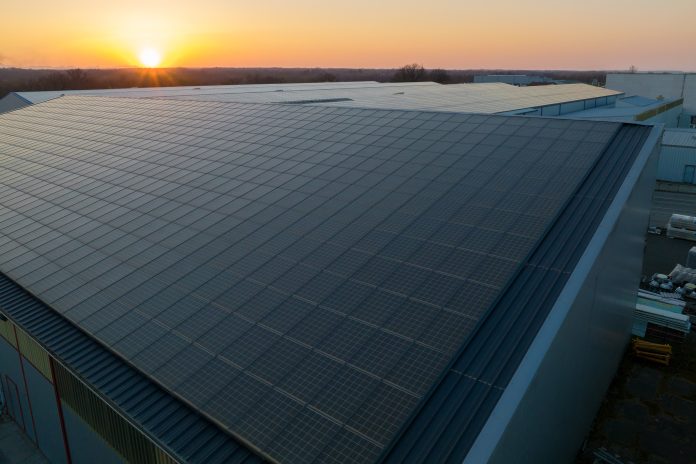In this article, Alice Bushell, senior associate at Eversheds Sutherland, explores how using green energy solutions, such as rooftop solar PV, could revolutionise warehouses across the UK
Rooftop solar PV on commercial properties should be a no-brainer. ESG and net zero targets are non-negotiables for businesses. The backdrop of the twin crises of climate and energy makes the lure of green energy with less price volatility from safe, established technology irresistible.
Beyond our shores, we can see other G7 economies taking up this opportunity. Germany increased its solar generation potential from commercial buildings by 51% in 2020 and 34% in 2021. With a recent study for the UK Warehousing Association finding that UK warehousing has the roof space to double the UK’s solar capacity: now is clearly the time to strike.
Repair, maintenance, and allocation of risk are the main barriers to solar PV adoption
UKWA’s study identified the negotiation of legal agreements, particularly agreeing on repair, maintenance and allocation of risk, as a key barrier to growth in this sector. Encouragingly, increasing numbers of clients (both landlord and tenant) are speaking to us about the best way to “green” their property portfolios, and solar is an important piece of the puzzle.
We do see similar obstacles come up time and again, and occasionally these will mean that the solar panels do not get installed or the ultimate position is ill-thought-through and unfairly structured, leading to all sorts of problems down the line. However, most of the obstacles can be managed, and with experience come tried and tested solutions that balance the parties’ legal and commercial interests.
There is clearly an appetite for growth in this area, and there are certain questions that parties new to the sector should ask themselves before embarking on their first rooftop solar project.
What sort of legal structure should we be using?
There is no market-standard legal structure in the UK. On the one hand, this can cause uncertainty, but on the other, it allows flexibility. The best structure in each case will depend on the following:
- Whether the building is currently tenanted, at the pre-let stage or owner-occupier;
- Who will bear the initial and subsequent expenditure
- The main motivation of the parties and who is driving the deal
- If it makes commercial sense to have an experienced, third-party solar company install, own and operate the panels and supply energy to the occupier
- The case for a building owner to create a separate asset class and aggregate the interests in rooftop solar across its portfolio
- How to export any excess energy to the national grid
- The likelihood of selling or financing the warehouses
- The best way to document “power purchase” provisions between the owner, occupier and, if involved, the solar company.
Where a third-party solar company will be involved on an ongoing basis, selling energy to the occupier, it is often appropriate to agree to an “airspace” lease of the air above the roof with a corresponding power purchase agreement. This is also a model that landlords can employ to create a separate asset class, granting airspace leases to an SPV they incorporate.
Is an airspace lease the right way to go?
There can be something attractive about bringing in an experienced operator and granting them a lease of the air space above the warehouse. If an airspace lease is the best way forward, as a minimum, it will need to factor in the following points:
- If the building is held under a lease, variations may be needed to allow the airspace lease to be granted and the panels operated
- If the unit is tenanted, the landlord needs sufficient reserved rights to make this work
- The exercise of the operator’s rights will have to dovetail with and, crucially, not inhibit the primary use of the building
- One of the parties is going to have to have ultimate responsibility for things like repair of the roof, maintenance of the panels and insurance of each, but both will need to work together
- The commercial terms for the supply of electricity
- The reality that the occupier of the warehouse may change, whether that is through a sale, letting, assignment or subletting
- How the arrangements can be unwound and when.
How do we build consensus?
Deciding which structure is best will involve consulting with internal stakeholders (asset managers, investment managers, treasury, ESG managers etc.) and other third parties (including insurers, technical specialists, and rent review surveyors).
Everyone will have different concerns, but whilst this process can take time, building consensus is crucial. Even on the “home side”, views on taking this forward may vary: an ESG director may see solar PV as an easy win, whereas an asset manager could, understandably, take a classic real estate investor’s “pound for pound” recovery mindset.
The project’s success relies on the stakeholders pooling their experience to make the installation work on as many levels as possible.
Building consensus with an opposite side, be they tenant, funder or occupier, can require a different approach. It is not unknown for parties to agree on something broad at the head of terms stage, only for the deal to be stalled once detailed negotiations to commence and one or both parties realise they need specialist expertise.
Both sides need to see the value but also the responsibility that will come with the project and how it will work in practice. One party taking a blind faith approach may get the deal done quicker, but it could be storing up problems for the future.
How should risk be apportioned?
From a warehouse occupier’s perspective, solar panels on the roof are always going to be secondary to the primary use and purpose of the building. Whereas a third-party solar company whose experience stems from ground-based solar or the different commercial drivers behind the “free solar” model (that we used to see until the closing of the Feed In Tariff scheme) may initially struggle to reconcile with this, in favour of a focus on protecting the solar installation above all else.
While you see rooftop solar PV on everything from homes to cathedrals to warehouses and it is generally seen as a mature technology, asset managers would not be doing their jobs properly if they did not assess any additional risks that may be posed.
The differing drivers, especially when it comes to who carries risk, can cause projects to fail. Commercial positions need to be understood and balanced. The parties must be able to agree:
- Who must sign off on the initial specification?
- Who will insure, and at what level?
- Who will carry out maintenance, and how often?
It is by drilling down into the detail with their specialists that the parties can understand, apportion and manage any risk.
What else is there to think about when it comes to solar PV adoption?
As with any property deal, there will be a raft of considerations specific to the property and the parties. These can veer into specialist areas. A suggested list of points to consider:
- Whether the roof is suitable for and can support the solar panels
- The installation will not void any building warranties which may still be live
- The position in respect of capital allowances
- The effect of the PV System on building rates
- If any planning permission or other consents are required in order to install the PV System
- The effect of the PV System on future sale / re-letting / financing of the Premises
- No other consents would be needed to grant the airspace lease (for example, consent of a lender) if that is the chosen structure, and there are no other third-party interests which might be problematic or any restrictive covenants which would prohibit the installation of the solar panels.
Rooftop solar PV is an increasingly important solution for owners and occupiers of buildings for ESG, energy security, cost and marketability reasons. These schemes can be effectively deployed, but to do so, parties must understand the importance of embarking on a scheme with a clear plan for structuring the bargain and allocation of risk.
There are very few stakeholders that do not see the benefits offered by solar PV in warehouses. However, none of this could yet be classed as “mainstream”.
Still, most risks and concerns can be addressed and managed, and as time goes by, the mechanisms for doing this are becoming tested, accepted and trusted.

















